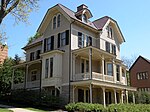Chatham University Arboretum

Chatham University Arboretum (32 acres) is an arboretum located on the campus of Chatham University at Woodland Road, Pittsburgh, Pennsylvania, United States. It is open to the public daily without charge.The arboretum was originally Andrew Mellon's estate, with portions designed by the Olmsted Brothers, landscape architects in the 1930s. It was designated an arboretum on November 9, 1998, and now contains approximate 100 types of trees, including Japanese flowering crabapple, river birch, and Kentucky coffee tree. The Arboretum provides an outdoor classroom for students in Chatham's Landscape Architecture and Landscape Studies programs, as well as a place for walking and meditating.
Excerpt from the Wikipedia article Chatham University Arboretum (License: CC BY-SA 3.0, Authors, Images).Chatham University Arboretum
North Woodland Road, Pittsburgh
Geographical coordinates (GPS) Address Website Nearby Places Show on map
Geographical coordinates (GPS)
| Latitude | Longitude |
|---|---|
| N 40.44757 ° | E -79.92344 ° |
Address
Chatham University
North Woodland Road
15232 Pittsburgh
Pennsylvania, United States
Open on Google Maps





